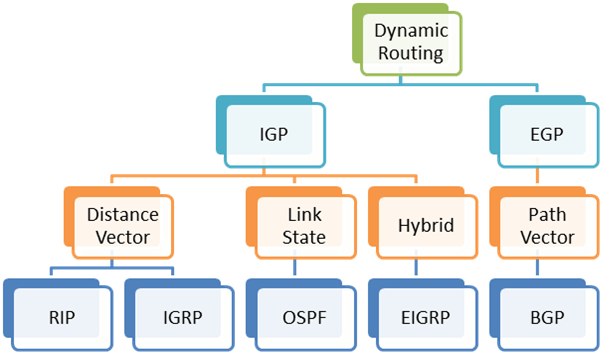Dynamic Routing is a routing process in which routers share their routing table with the neighbor router with the help of various routing protocols. This routing process is widely used in the enterprise network. In, this article, we will discuss Dynamic Routing. So, let’s start a detailed discussion on Dynamic Routing.
What is Dynamic Routing?
Dynamic Routing is a process in which routers share their prefix (routes) information to their neighbor devices using some routing protocols. Router share their routing table or network routes with the neighbor router using routing protocols. As soon as, there is a change in the network, these routing protocols detect that change and automatically propagate that change to neighbor devices.
Dynamic Routing Protocols

Dynamic Routing, use some routing protocols in order to share their routing table or network prefix information with the neighbor router. They are IGP (Interior Gateway Protocol) and EGP (Exterior Gateway Protocol). Famous, IGP protocols are RIP (Routing Information Protocol), EIGRP (Enhanced Interior Gateway Routing Protocol), OSPF (Open Shortest Path First) and IS-IS (Intermediate System to Intermediate System). On the other hand, EGP has an only protocol which is BGP (Border Gateway Protocol). However, different routing protocols have different properties.
Usages of Dynamic Routing
Unlike static routing, dynamic routing is used for the larger network. It provides automatically updates whenever there is a change in the network. Main usages of Dynamic Routing are:
- It is used in a larger enterprise network.
- Dynamic Routing helps to keep network routes up in big Data Center.
- It is usually used by ISP (Internet Service Provider) to keep their network up without any downtime.
- Dynamic Routing provides automatic updates so it prevents downtime in a network.
Advantage of Dynamic Routing
- No need to know all networks of an enterprise or campus network.
- Required to advertise only directly connected networks.
- Administrator work is reduced.
- Automatic update if there is a change in the network.
- Suitable for a large enterprise network.
- Automatic update of routes, so router built their routing table automatically.
- With the help of dynamic routing, we can easily propagate static or default routes to other routers.
- Overall maintenance of the network is easy in comparison to static routing.
The disadvantage of Dynamic Routing
- The CPU utilization of the router or any other layer 3 devices will increase.
- Dynamic Routing consumes a lot of link bandwidth.
- Require higher knowledge in order to configure dynamic routing.
- A higher configuration device is required in order to configure dynamic routing, which costs high.
Reference
Summary
In this article, we discussed dynamic routing. Dynamic Routing is very helpful in a large enterprise network. It also helps to prevent downtime in any network. In dynamic routing, routers share their routing table with a neighbor router with the help of various routing protocols. In this routing process, if there is some change in network topology, those changes automatically propagate to the whole network.